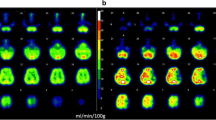Abstract
Two patients with Lhermitte-Duclos disease were evaluated by brain positron emission tomography (PET) and technetium-99m-ethyl cysteinate dimer (99mTc-ECD) single-photon emission computed tomography (SPECT). In the lesions in both patients, hyperperfusion was detected on cerebral blood flow images obtained by PET, and hyperactivity by standard 99mTc-ECD SPECT. Dynamic 99mTc-ECD SPECT images demonstrated a plateau of activity in each lesion. These findings suggest that lesions in Lhermitte-Duclos disease have a retention mechanism for 99mTc-ECD equivalent to that of normal neural tissue.
Similar content being viewed by others
Author information
Authors and Affiliations
Additional information
Electronic Publication
Rights and permissions
About this article
Cite this article
Ogasawara, K., Yasuda, S., Beppu, T. et al. Brain PET and technetium-99m-ECD SPECT imaging in Lhermitte-Duclos disease. Neuroradiology 43, 993–996 (2001). https://doi.org/10.1007/s002340100617
Received:
Accepted:
Published:
Issue Date:
DOI: https://doi.org/10.1007/s002340100617




